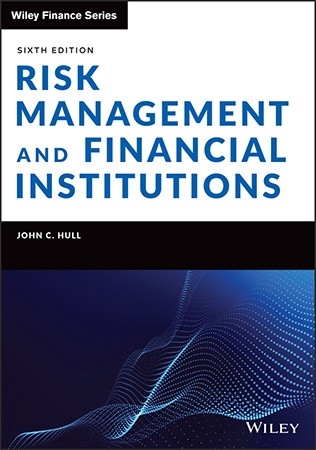Risk Management and Financial Institutions, 6E by John C. Hull

Chapter 1
Introduction: Risk‐Return Trade‐offs
Imagine you are the Chief Risk Officer (CRO) of a major corporation. The
Chief Executive Officer (CEO) wants your views on a major new venture.
You have been inundated with reports showing that the new venture has a
positive net present value and will enhance shareholder value. What sort of
analysis and ideas is the CEO looking for from you?
As CRO it is your job to consider how the new venture fits into the
company's portfolio. What is the correlation of the performance of the new
venture with the rest of the company's business? When the rest of the
business is experiencing difficulties, will the new venture also provide poor
returns, or will it have the effect of dampening the ups and downs in the rest
of the business?
Companies must take risks if they are to survive and prosper. The risk
management function's primary responsibility is to understand the portfolio
of risks that the company is currently taking and the risks it plans to take in
the future. It must decide whether the risks are acceptable and, if they are
not acceptable, what action should be taken.
Most of this book is concerned with the ways risks are managed by banks
and other financial institutions, but many of the ideas and approaches we
will discuss are equally applicable to nonfinancial corporations. Risk
management has become progressively more important for all corporations
in the last few decades. Financial institutions in particular are finding they
have to increase the resources they devote to risk management. In spite of
this, financial institutions still make mistakes. In March 2021, Archegos, a
hedge fund managing the assets of a rich private individual named Bill
Hwang, went bankrupt as a result of highly levered risky investments.
Several banks that the hedge fund had been dealing with lost huge sums. It
is reported that Credit Suisse lost over $5 billion and Nomura lost almost $3
billion as a result of their dealings with Archegos.
Risk management is not about minimizing risks. It is about ensuring that the
risks taken are manageable and that the expected returns are commensurate
with the risks being taken. This chapter sets the scene. It starts by reviewing
the classical arguments concerning the risk‐return trade‐offs faced by a
well‐diversified investor who is choosing a portfolio of stocks and bonds. It
then considers whether the same arguments can be used by a company in
choosing new projects and managing its risk exposure. The chapter
concludes that there are reasons why all companies, including financial
institutions, should be concerned with the total risk they face, not just with
the risk from the viewpoint of a well‐diversified shareholder.
1.1 Risk vs. Return for Investors
We now examine the theoretical trade‐off between risk and return when
money is invested. The first point to note is that the trade‐off is actually
between risk and expected return, not between risk and actual return. The
term “expected return” sometimes causes confusion. In everyday language
an outcome that is “expected” is considered highly likely to occur.
However, statisticians define the expected value of a variable as its average
(or mean) value. Expected return is therefore a weighted average of the
possible returns, where the weight applied to a particular return equals the
probability of that return occurring. The possible returns and their
probabilities can be either estimated from historical data or assessed
subjectively.
Suppose, for example, that you have $100,000 to invest for one year.
Suppose further that Treasury bills yield 5%. One alternative is to buy
Treasury bills. There is then no risk and the expected return is 5%. Another
alternative is to invest the $100,000 in a stock. To simplify things, we
suppose that the possible outcomes from this investment are as shown in
Table 1.1. There is a 0.05 probability that the return will be +50%; there is a
0.25 probability that the return will be +30%; and so on. Expressing the
returns in decimal form, the expected return per year is:
This shows that, in return for taking some risk, you are able to increase your
expected return per annum from the 5% offered by Treasury bills to 10%. If
things work out well, your return per annum could be as high as 50%. But
the worst‐case outcome is a −30% return or a loss of $30,000.
Risk Management and Financial Institutions, 6E by John C. Hull




